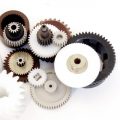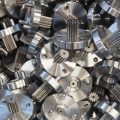Why do gears make a noise? I think this is one of the most discussed technical topics in mechanics. I would like therefore to clarify that this post isn’t meant to be a theoretical technical article but only a general informative line referring to our specific field, namely that of very small gear motors.
I will start from a premise. Noise, as perceived by the human ear, is subjective and we tend to tolerate low frequencies as opposed to high ones; so the absolute value in decibels detected by an instrument – such as a phonometer – is not decisive but only indicative.
The noise causes of a gear transmission can be grouped into six macro categories:
gears errors (inappropriate quality grade)
vibrations transmitted
torsional rigidity of the axles and of the housing
housing resonance
gearbox position
wrong lubrication
From this short list it is already possible to deduce that it is incorrect to attribute the nature of noise only to gears because they are considered the only moving parts. As we said last week, the association of high noise = incorrect gears is a superficial but spontaneous evaluation.
As mentioned last Wednesday it also goes without saying that if the application is sensitive to noise, it is absolutely necessary to assign to the gear teeth in question an appropriate degree of quality, based on the regulations in force. Unfortunately, however, it often happens that we need to deal with drawings that do not mention either the degree of quality required or the relative reference standard, a situation that may be due to a lack of relevant knowledge on the part of the person that produced the drawing or a lack of specific experience of the designers themselves who, in the uncertainty of requesting gears that are too precise and therefore expensive or too imprecise and therefore unsuitable, end up omitting this information, leaving the title block blank.
It is therefore better to use persons with specific experience and expertise in the design of gear toothing: the theoretical profile of gears is almost never correct and it is often necessary to perform a number of functional tests and to gradually “adjust” the tension at the prototype stage.
The small and very small gear motors typical of our activities are driven by low voltage micro-motors which, by their nature, have very high rotation speeds and, if not perfectly balanced, already in themselves generate noise and vibrations transmitting them to the housing and to the gears through the gear fixed to the motor itself. Logically then the technical choice of the motor is also of great importance.
The rigidity and resonance of the housing depend on how it is designed, the materials used and the constructive precision.
Positioning is another factor that must also not be overlooked: a gearbox that has been well made and that is virtually silent could give unpleasant surprises if assembled, for example, inside a unit or a cabinet (therefore with empty wooden crate) for the electric mechanism of a door, a drawer or something else.
Finally, lubrication also has its own importance. In fact in the gear reducer there are high speed gears and low torque (near the electric motor) and low speed gears and high torque (near the output shaft). This already presupposes a “mediation” of product characteristics, to which must be added the type of meshing (for example cylindrical gears have different needs from worm gears), the type of constructive materials used and the different characteristics of the application itself, therefore use temperature, operating time, duration, and so on.
Today there are lubricants for all applications and it is not uncommon to see excessive quantities of these substances in gearbox. It is better, in my opinion, to invest in a high quality product and in an appropriate dosing system that allows use of the minimum necessary quantity rather than the “plentiful” use of a generic low cost product.



